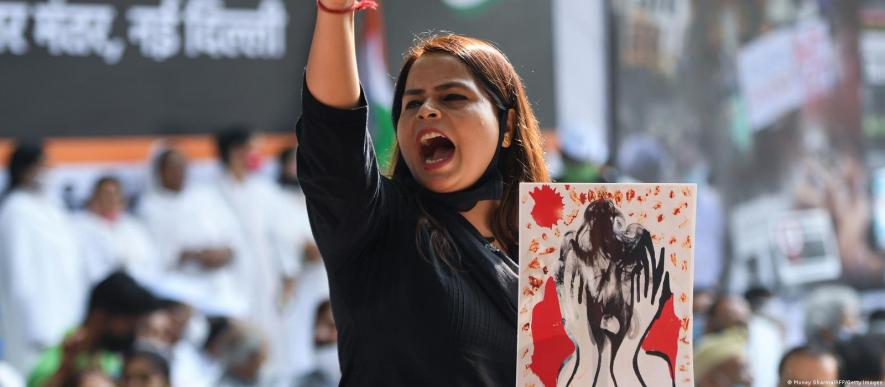The UN Seeks Femicide Stats — and India is Undercounting

On November 12, news broke of a young woman in Delhi who was strangled and dismembered by her live-in partner. He scattered bits of her body across the capital. That came shortly after a high-profile killing in August in which a 19-year-old in Jharkhand was burnt to death in bed by her stalker. The incident caused outcry and brought many people to the streets in protest.
Nishi Mitra, an anthropologist at the Tata Institute of Social Sciences in Mumbai, has spent some years scrutinizing India's annual crime data to understand the extent of femicide, or the killing of women because of their gender.
Data, however, aren't recorded in India in a way that would allow anyone to identify or count femicides. The killings of women are recorded as regular homicides.
"The data is the biggest issue," she said. "The problem still remains invisible."
Mitra was one of the few people in India to use the word "femicide" when she published a research paper on the topic in 2016. Even the definition of the term was unclear at the time. Was it a femicide anytime a man killed a woman? Was it still femicide if another woman had done the killing? Did the motive matter? There was no consensus — within India or globally.
"The most important factor of why we need this term is to make visible crime which has eluded the criminal justice system, wherein murder of women is not really understood," Mitra said. "And the complex gendered factors by which violence gets invisibilized and institutionalized is not taken into cognizance."
![]()

Women shout slogans as part of a protest against the release of men convicted of gang-rape in New Delhi in August 2022Image: Sajjad Hussain/AFP/Getty Images
As part of an effort to track femicides across its member states, in March 2022 the United Nations established a framework to record the gender-related killings of women and girls by intimate partners, family members or unknown perpetrators.
Records show inconsistencies
Although motives for homicides are listed by the police in annual reports released by India’s National Crime Records Bureau (NCRB), there is no specific information on why the female victims were killed.
The total number of homicides of women also does not tally with other numbers presented later in the report. The sum of cases listed under "murder with rape," "dowry deaths" and "abetment to suicide" far exceed the homicide total. This mismatch has partly to do with how cases are classified when multiple crimes are involved.
Mitra said this was because of a lack of consistency from year to year.
"The report keeps changing its categories of data collection, so their comparability (across years) is very problematic," she said. For example, "murder with rape" did not exist as a category till 2017, although the NCRB data has existed since 1993.
Though femicides are not recorded as such, there are official statistics for other forms of violence against women.
Assam records the most violence despite underreporting
The northeastern state of Assam is known for its tea estates and lush rainforests. It is also, according to NCRB data, the state with the highest rate of violent crimes against women.
Assam saw more than 800 cases of violent crimes against women per million people in 2021, when the national average was 282. Delhi recorded 690 cases per million the same year. Odisha (685), Haryana (563), Telangana (552) and Rajasthan (512) follow. Nagaland, Gujarat and Tamil Nadu are the states that report the lowest rates of violence against women, at 25, 105 and 111 cases per million people, respectively.
The North East Network (NEN), a women's rights organization, has been active in the region for several years. Anurita Pathak, NEN's Assam project coordinator, seems unsurprised by the numbers.
"What you're seeing is just the tip of the iceberg," she said. "I'm saying that below the surface are many more cases. Like cases that are handled by our Kendra."
NEN has established safe spaces for village women, known as Grameen Mahila Kendra. They provide psychological care and social services to people experiencing violence at home, work or elsewhere. By involving local workers trusted within their communities, NEN has managed to reach a very vast pool of women. Pathak said those women did not show up in the NCRB data — as the cases are dealt with at community level and not registered at a police station.
"Not every woman who is battered or abused will go to the station," she said.
The reluctance is also historical. Assam has a long history of armed conflict and ethnic clashes — in which women have been vulnerable to sexual abuse. Some experts have even called it a "combat tool."
"Once upon a time, the entire idea of safety revolved around law and order — because the state was going through so many conflicts. That hardly left any people talking about gender, women and safety," Pathak said.
Through the work of NGOs and the UN's Jugnu Clubs, in recent years more women in Assam have opened up about their experiences with gender-based violence. Their accounts show that gender-based violence is vastly underreported in the state that was already statistically India's worst.
Incidentally, the state to record the lowest rate of crimes against women is Assam's immediate neighbor: Nagaland. However, according to NEN, people who experience gender-based violence in the state face the tyranny of customary laws.
"Customary laws are oral. Not all are written. They are passed from one generation to the next," Pathak said. "They have a body of patriarchs, mostly men, who decide on these cases. This really disadvantages women."
Because of this, Nagaland's NCRB data are likely to be unreliable.
'A complicated phenomenon'
As Indian women have become more empowered financially, professionally and socially, the assaults have not abated. In fact, a study published in 2021 shows that women who earn equal to or more than their partners in India experience more domestic violence.
"It's circular. Gender violence is an expression of patriarchy," said Manali Desai, the head of the Department of Sociology at the University of Cambridge. "We find that single explanations — like crisis of masculinity or poverty or financial insecurity — cannot explain such a complicated phenomenon."
Desai runs a project that is comparing patterns and causes of violence in Delhi with Johannesburg, South Africa. She finds that, in spite of rapid urbanization and high crime in both regions, the conversation around gendered violence is very different.
"In South Africa, we didn't find that women had any problem talking about violence," Desai said. "They were very open about it. It's a problem right up front — in contrast with India, where everybody's pretending this is not a problem that they'll ever come across."
The group's work suggests that suppression is one of the issues preventing India from finding viable solutions to violence against women. There is also evidence to show that violence, at some levels, may be accepted by many.
The latest National Family Health Survey, conducted from 2019 through 2021 and released in 2022, polled Indians about their "attitude towards wife-beating." The survey found that 45.4% of women and 44.2% of men said it would be OK for a man to beat his wife for certain reasons.
NCRB's data confirm that this belief translates into reality: Domestic violence is the predominant crime against women in India. It accounts for 35% of all violent crimes against women on average each year.
Femicide observatories in the making
As the UN calls for an effort to count femicides around the world, many countries are facing the same hurdles as India. For years, data hasn't been recorded in a format conducive to counting femicides. In all such countries, it will require changes within the criminal justice system, the police and the government to overcome that.
Mitra is attempting to lead the charge in India. She is trying to launch an observatory to track femicides in collaboration with government agencies and researchers. Similar observatories exist in Israel, Canada and Poland. Mitra said India could learn from their models and develop its own.
"Globally we are recognizing that we need to keep improving our criminal justice system to recognize the human right of women to live without violence. That is what we are trying to do," she said.
"But the magnitude of the problem is the first thing we need to contend with."
Edited by Milan Gagnon, Rodion Ebbighausen and Gianna Grün
Get the latest reports & analysis with people's perspective on Protests, movements & deep analytical videos, discussions of the current affairs in your Telegram app. Subscribe to NewsClick's Telegram channel & get Real-Time updates on stories, as they get published on our website.























